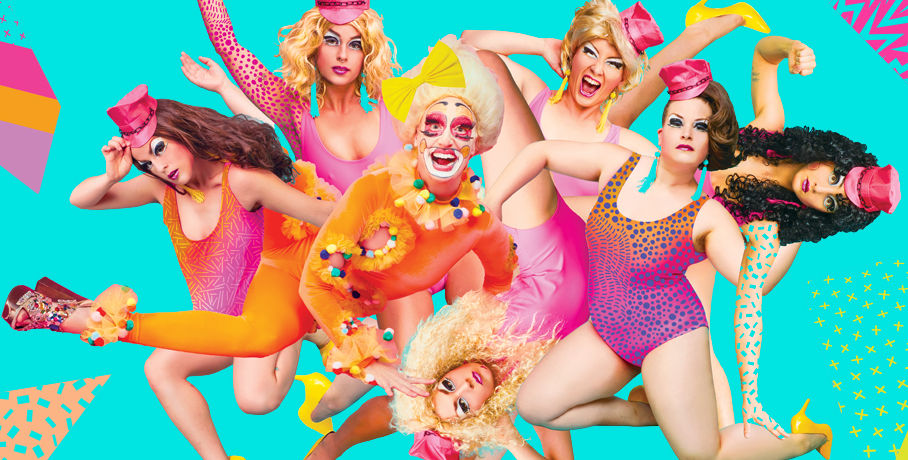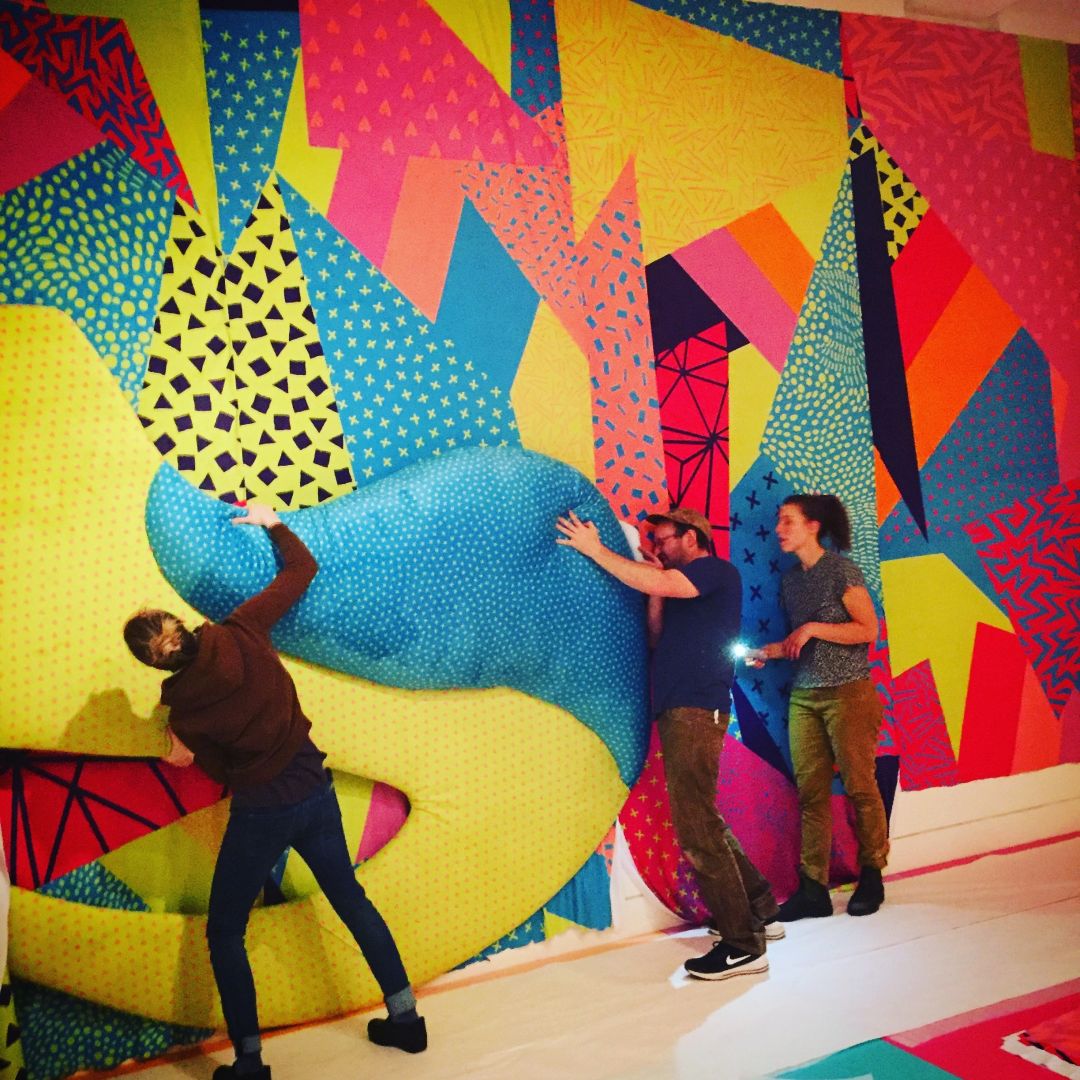Cherdonna Shinatra's Wild New Dance Installation Hits the Frye Art Museum

Cherdonna Shinatra and her supporting dancers will appear in Ditch.
Image: Courtesy Frye Art Museum
Seattle dance artist Jody Kuehner has been working under the persona of Cherdonna Shinatra for a decade now, mashing up drag, dance, and clowning into something brightly absurd. In her newest piece, Ditch, Kuehner will set about dismantling patriarchal norms (say, an art museum) with body-wobbling glee. The art installation opens Friday night at the Frye Art Museum and includes MomDonna, a giant matriarchal figure who will “birth” seven dancers (Cherdonna included) each day for an hour-long dance performance. During those shows (performances begin on January 26), Cherdonna will try to make everyone on earth happy, says Ditch's description, “in the face of an oppressive existence."
Ditch will appear alongside work by Tschabalala Self and The Rain Doesn’t Know Friends From Foes, a mixed media installation examining life as theater by three Dubai artists (Ramin Haerizadeh, Rokni Haerizadeh, and Hesam Rahmanian).
I talked with Kuehner about the realities of putting on 80 performance in three months and why museums might be an ideal spot for her brand of dance.
How did this come about with the Frye?
It's been sort of a long process. I think it's always interesting, because as you see artists in town—because they get a lot of opportunity in Seattle—it's like, Wow Jody just got asked to do something at the Frye! And it's actually been a three-year process of me annoyingly bothering the Frye. It started when Jo-Anne [Birnie Danzker, the Frye’s former director] was there. I had been talking to her and pitching this project and going to multiple meetings and doing some grant-writing for the work. It just took that long for the Frye to take it on.
Was there some of that original idea, the kernel of it, that ended up being in this current piece?
It's morphed a lot. But I knew I wanted to do something in a museum setting. And part of that was a response to a lot of feedback of my work in Seattle not being dance and [I’m] pretty annoyed with that. What does dance exactly look like? My training is in dance performance and that's my way into work always. But I love to create a space and use lots of costuming. So the minute I was in the museum—because museums are for paintings or more static works of art that are not human bodies—it's like, Oh wow she's a dance artist, it's so much dance! When I'm in the museum, nobody questions that I'm doing performance and using my body.
With the performance schedule, it seems like at some points you might be performing for no one or very few people. What do you think the effect of that is and will you be performing if there's absolutely no one in the room?
For sure, for sure. That's definitely part of the rigor of the work. I think for me and for my dancers—being somebody who's in a world of performance where everything is built to have people witness what you're making—it is an interesting question. I'm fully aware that people will maybe wander through and look for two minutes and move on to the next gallery. What will they take away if they only see two minutes of the piece?
How will that interact with the themes of this particular piece and I guess your work in general?
This piece is definitely about taking up space. Some of the language that we've put out about the work is about these queer femme bodies really inhabiting that space. Even when nobody is in the room, the seven of us can have an experience that will be moving so that the work is also about us in it.
How similar will the performances be? Will it be almost entirely improvised or will you have a framework you're playing off of?
It's pretty structured right now and there are a couple moments that are more open. That's part of the experiment. Maybe by show 50 my dancers will revolt and be like, Screw this. We don't want to do this anymore. I have no idea. Maybe somebody will get injured or sick. Or maybe it will be like we're going to the office everyday and become very routine and mundane. I feel like there could be a possibility that by show 55 I'm like, you know, let's just do something else today.
Have you done anything similar?
I haven't. I've done durational works but it's more about how many hours you do. It’s such a gift that the Frye is willing to let us be in there that many days and do a show and that it's free. To get to practice, also in the more practical term for movement artists to have a practice for 80 times. That is unheard of.
It's also a little push against how we've set up dance performance where you get to do one maybe two weekends. I danced for Pat Graney for nine years and sometimes her process was two or three years long and then you do one weekend at On the Boards and it's so disheartening and sad. And beautiful. It can be really beautiful. But it's also like, you know what, let's do this 80 times. Let's work on this piece for two to three years and really get to do it.

MomDonna installation begins at the Frye.
Image: Courtesy Jody Kuehner
Anything else you want to add?
We call her MomDonna, this huge sort of matriarchal ruin in the space. MomDonna is in the space as if she's been there for thousands of years seeing humans just keep trying. I think there's a little of that existentialism in the piece and that relates to our daily practice of coming in and retrying. The piece happens for an hour each day—it starts and it ends. And our day starts and ends, and our weeks, and our months, and our lives, and that sort of cyclical repetition of things, what we leave behind and what we're striving to try to do.
Do you think that—again going back to how this fits into a museum and static works of art—performance is by its nature ephemeral in a way that mimics human life more than a painting does because it can live on for hundreds of years?
Yeah, exactly. Definitely all those things.
Have you ever used this MomDonna before or is it just for this piece?
Just for this piece. I do have this reoccurring theme of bodies and this mother figure or oracle. I think that's mainly because as a person in the world I have a lot of existential feelings so they just get in the work. My last solo I had all these twelve-foot dolls that were recreated from a doll that my mom had made me in my childhood. Now I have this giant mother figure. She's new but she's sort of still coming from somewhere. I think maybe I'm making one giant piece my entire life with these loose threads that go between each work.
Cherdonna Shinatra: Ditch
Opening reception, Jan 25, 7:30–9:30
Jan 26–April 28, Frye Art Museum, Free




